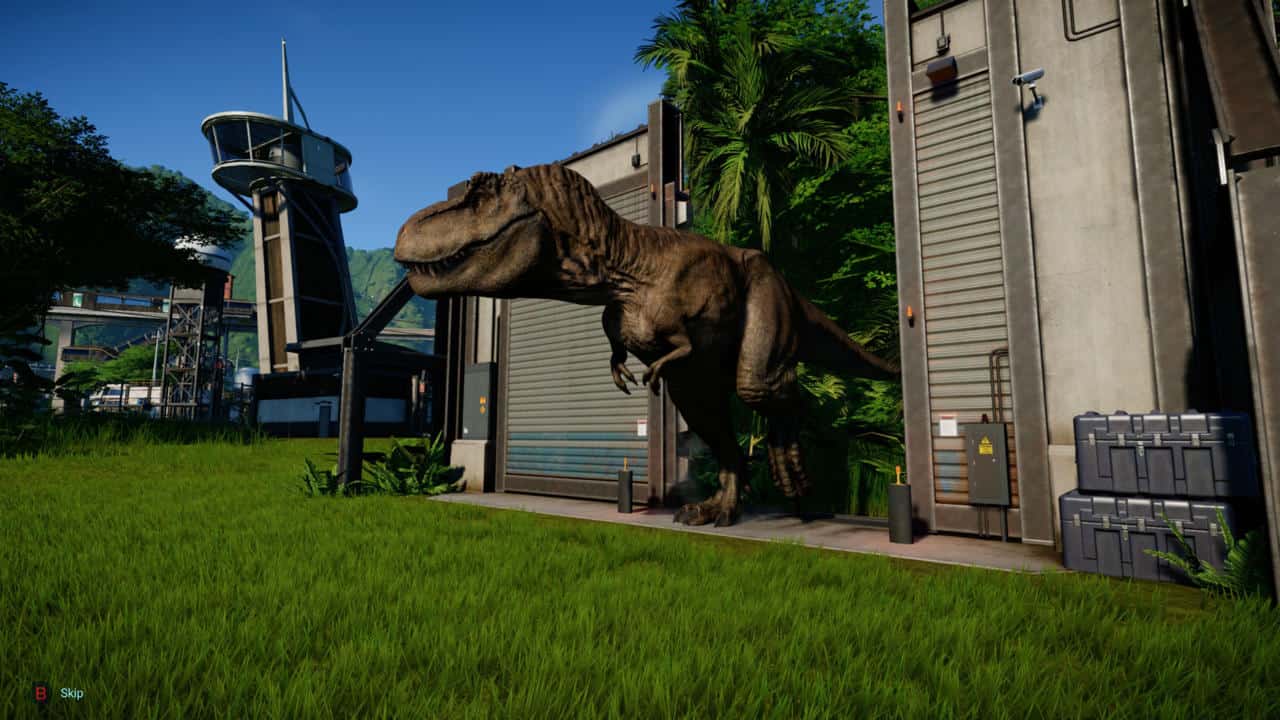
Whether you’re reminded of vicious raptors hunting terrified children, placid Brachiosaurus strolling verdant hills, or a scientist reaching elbow-deep into a mound of Triceratops dung, the words “Jurassic Park” can evoke some pretty powerful memories. Jurassic World Evolution reinforces these associations with its take on dino-park management, and all the good and bad that comes with such a brazen endeavor. It can be a bit clumsy at times, but Evolution ultimately finds a comfortable middle ground between establishing deep mechanics and maintaining accessibility for the average dino enthusiast.
Your venture kicks off with a warning from Dr. Ian Malcolm–voiced by Jeff Goldblum himself–who ruminates about the inevitability of disaster before dropping you straight onto the first of the game’s five main islands. To successfully run your new park, you need to maintain a variety of dinosaur species and build facilities to protect and entertain paying customers. Do well enough and you unlock additional islands for your expanding park, each with a new curveball to keep you on your toes, be it aggressive weather systems, unique financial constraints, or limited construction options.
After learning the basics of construction and dinosaur creation, you’re introduced to the three divisions that make up your park’s staff: science, entertainment, and security. Each division will offer contracts that, when completed, give you cash and raise your reputation with that division. This unlocks further items and buildings for research, as well as that division’s story mission. While contracts are a good source of money in the early game, they come with an odd complication: completing contracts for one division lowers your reputation with the other two. This creates a nonsensical balancing act that, whilst not difficult to overcome in the long run, feels arbitrary in context.










Building a good dinosaur park isn’t as simple as putting down some fences, incubating dino eggs, and sitting back to watch them majestically take their first steps into the world. You’ll need to manage everything from dig sites and DNA extraction to general park maintenance via your rangers–who will fill feeders, fix fences, and keep everything in working order. In an awesome twist, you can manually control the rangers’ Jeeps or helicopters from a close third-person perspective, leading to some surprisingly beautiful and memorable moments as you mingle with the great beasts inhabiting your park.
If you’ve played any kind of park management sim before, you’ll feel right at home with how everything works thanks to streamlined controls and an elegant UI. Console players can similarly rejoice as controller configurations are surprisingly intuitive, making navigating everything a breeze.
With the exception of cash, all your research and item progression is shared across each of the islands, and you can freely move between them at will once they’re unlocked. If you’ve got something you want to research but you’re struggling with funds in your current park, switch back to your previous one and spend their money on it instead. Although it would be a time saver to simply let you funnel cash from one park to another, going back to old parks never feels you’re like taking a step backwards. Research progression is skewed so that you’ll unlock the next park before you’ve unlocked all the research items in your current one, so you’ll always feel like you’re achieving something worthwhile, even if that means re-visiting old areas.
Interestingly, unlike most other park management sims, you can’t speed up the flow of time while waiting for tasks to complete, but it’s not as detrimental as it sounds. It’s rare that there isn’t something in the park needing attention, and more often than not you’ll be thankful for the time.











Each of the dinosaurs in your menagerie have particular needs–some are placid, solitary creatures who are super chill, while others are quick to go on high alert. Put a herbivore in a pen full of meat-eaters and it will (understandably) panic. Put two aggressive meat-eaters next to each other and they’ll probably fight to the death, unless you can get your rangers in there to tranquilize and then separate them both before any real harm is done. Learning the differences between each species is an important part of keeping your park operating smoothly. But even when things are going well, calamity never feels that far away.
From rampaging dinosaurs and tropical cyclones to internal sabotage, there’s always something ready to trash your hard work. While dealing with these hazards can be exciting in your early hours, the fifth time your Ankylosauruses make a break for it because they don’t like being around other dinosaurs can get tiresome. Attacks on park goers can initially be costly; later on, when you’ve got money to burn, a few lawsuits digging into your bottom line doesn’t matter much. But while the lack of surprises and stakes after 20 or so hours is a bummer, it’s never enough to take away from the joy of watching your creations live out their lives in structures you’ve meticulously designed and maintained.
Evolution captures the essence of Jurassic Park while being a good park management sim in its own right.
When your coffers fill up, you can really cut loose with how you build up your parks across each island. A maxed-out park is a sight to behold as thousands of guests wander the attractions. Hotels let you increase your parks’ capacity to house more people, while shops and arcades will keep them entertained for when they aren’t gathering in one of the many viewing platforms that line the fences keeping your dinosaurs in. When it’s all working, it’s like watching the components of a well-oiled machine tick over. Though it’s similarly fun, albeit sadistic, to watch a full park of guests scramble for the emergency shelter when you trigger the alarms.
If there’s one word that could easily describe Jurassic World Evolution, it’s “faithful.” Taking control of a ranger behind the wheel of a Jeep in the rain and sidling up to a pack of socializing Stegosaurus is as epic as it sounds and is a definite highlight, as is releasing a newly recovered species into your park. Despite the campaign stumbling over itself and losing focus towards the end, Evolution captures the essence of Jurassic Park while being a good park management sim in its own right.





More Stories
Firefighting Simulator – The Squad review — Through the fire and the shame
Maid of Sker review — Death in the slow lane
PHOGS! review – It’s a dog-help-dog world out there